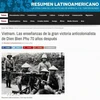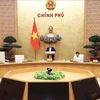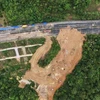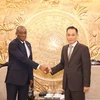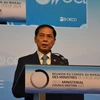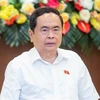Vietnam is delighted at the Lao People’s Revolutionary Party’s (LPRP) achievements over the past 60 years, and has full confidence that Laos will build upon its successes in preparations for the 10th National Congress in 2016.
Since its establishment 60 years ago (March 22), the LPRP has guided its people towards national liberation and prosperity.
Back in 1930, the Lao revolution was placed at the helm of the Communist Party of Indochina, predecessor of both the Communist Party of Vietnam and the LPRP. An uprising on August 23, 1945 forced King Sivavangvong to abdicate his throne nearly two months later, on October 11.
On October 12, 1945, the provisional revolutionary government of Laos presented itself to the public, declaring Laos an independent and free nation.
After Laos declared independence, French colonialists, with US and UK support, returned to invade Laos, Vietnam and Cambodia again. Under the leadership of the Communist Party of Indochina, an anti-French resistance war broke out across Laos.
During its second Congress in February 1951, the Communist Party of Indochina decided to establish a Party in each country to lead respective revolutions. After years of preparation, the Lao People’s Party, currently known as the LPRP, was formally established on March 22, 1955 and led by General Secretary Caysone Phomvihane, marking a historic milestone in Laos’ revolutionary history.
On December 2, 1975, the Lao People’s Democratic Republic was founded, opening a new chapter for the nation towards socialism under the leadership of the LPRP.
In 2006-2014, Laos’ economy grew by nearly 8 percent annually, well above the 4.8 percent recorded in 1986-1990. The average income per capita rose to 1,692 USD in 2014 from 114 USD in 1985.
The great feat is first of all attributable to the LPRP’s policy of prioritising human resource and socio-economic infrastructure development as well as the living conditions of the people.
The healthcare network has been expanded to reach almost every village. The education sector also saw remarkable development, with more than 115,500 university and college students nationwide during the 2013-2014 academic year. The country has also become sufficient in rice and has some for export.
These achievements form a solid foundation to lift the country above the under-developed status by 2020, as mentioned in the resolution set by the 9 th National Congress of the LPRP.
With a 2,000 kilometre shared borderline, Vietnam and Laos have long nurtured a traditional friendship and sense of mutual support. The special friendship and comprehensive cooperation between the two Parties, States and peoples has stood the test of time and become an asset that deserves protection and preservation.-VNA
Since its establishment 60 years ago (March 22), the LPRP has guided its people towards national liberation and prosperity.
Back in 1930, the Lao revolution was placed at the helm of the Communist Party of Indochina, predecessor of both the Communist Party of Vietnam and the LPRP. An uprising on August 23, 1945 forced King Sivavangvong to abdicate his throne nearly two months later, on October 11.
On October 12, 1945, the provisional revolutionary government of Laos presented itself to the public, declaring Laos an independent and free nation.
After Laos declared independence, French colonialists, with US and UK support, returned to invade Laos, Vietnam and Cambodia again. Under the leadership of the Communist Party of Indochina, an anti-French resistance war broke out across Laos.
During its second Congress in February 1951, the Communist Party of Indochina decided to establish a Party in each country to lead respective revolutions. After years of preparation, the Lao People’s Party, currently known as the LPRP, was formally established on March 22, 1955 and led by General Secretary Caysone Phomvihane, marking a historic milestone in Laos’ revolutionary history.
On December 2, 1975, the Lao People’s Democratic Republic was founded, opening a new chapter for the nation towards socialism under the leadership of the LPRP.
In 2006-2014, Laos’ economy grew by nearly 8 percent annually, well above the 4.8 percent recorded in 1986-1990. The average income per capita rose to 1,692 USD in 2014 from 114 USD in 1985.
The great feat is first of all attributable to the LPRP’s policy of prioritising human resource and socio-economic infrastructure development as well as the living conditions of the people.
The healthcare network has been expanded to reach almost every village. The education sector also saw remarkable development, with more than 115,500 university and college students nationwide during the 2013-2014 academic year. The country has also become sufficient in rice and has some for export.
These achievements form a solid foundation to lift the country above the under-developed status by 2020, as mentioned in the resolution set by the 9 th National Congress of the LPRP.
With a 2,000 kilometre shared borderline, Vietnam and Laos have long nurtured a traditional friendship and sense of mutual support. The special friendship and comprehensive cooperation between the two Parties, States and peoples has stood the test of time and become an asset that deserves protection and preservation.-VNA
